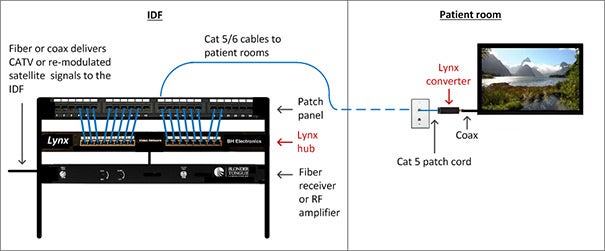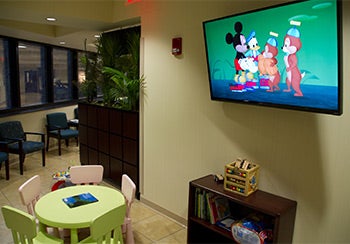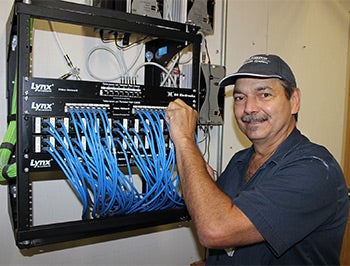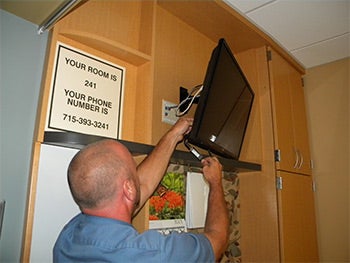Transitioning from analog to digital television systems
Patients expect not only high-quality medical care, they also expect first-rate customer service from professional and friendly caregivers along with clean attractive rooms and good food.
Another important amenity is good television service. Many tech-savvy hospitals are upgrading their televisions and the related equipment from analog to digital. Since aging coax distribution networks often have serious reliability issues, hospitals may need to replace the old coax to get dependable digital service — a costly, time-consuming, and messy process. One attractive alternative is switching to a television network that runs on twisted-pair cable.
 |
| Diagram courtesy of Lynx Broadband Layout of a twisted pair distribution network. An unpowered distribution hub in the wiring closet distributes RF signals on twisted pair cable. The signals do not pass through a network switch and do not use any bandwidth on the network. |
One advantage of a twisted-pair network is its "home-run" design, where each TV receives its service from a dedicated Category 5 or Cat 6 cable. This approach is much more reliable than the traditional tap and drop coax system, which has many taps and splitters between the signal source and the TV. This, in turn, means there are many copper-plated connectors along the pathway to the TV, and over a long period of time (approximately 10 years), these connectors can oxidize and cause a noticeable drop in signal strength and quality.
Thus, switching from a tap and drop coax system to a home-run, twisted-pair network can result in significant improvements in picture quality, reduction in TV maintenance expenses, and a high-quality signal that delivers digital and high-definition programming.
Another advantage of Cat 5 and Cat 6 cabling is that it cannot be compromised by maintenance personnel tapping into the system to add new TVs. Some well-meaning maintenance people will tap into coax to add a TV, but they will never splice into a data cable.
Finally, in new construction environments, setting up a twisted-pair network to the TVs provides a technology bridge to Internet Protocol TV (IPTV). This is an exciting new technology, but it is expensive and requires a lot of monitoring and maintenance from people with data networking expertise. By setting up a radio-frequency (RF) network that runs on Cat 5 or Cat 6, hospitals are setting up the infrastructure that facilitates an easy transition to IPTV at a later date.
Case 1: Pikeville Medical Center
Located in the beautiful Appalachian Mountains of southeastern Kentucky, the city of Pikeville and its 9,000 citizens celebrate the culture of the area with an annual Hillbilly Festival. The city is also well-known for the feud between the Hatfields and McCoys in the late 1800s.
 |
| Photo courtesy of Lynx Broadband Children can watch high-def TV in one of the waiting rooms at the new clinic at Pikeville Medical. |
In addition to its colorful heritage, Pikeville is home to two universities and one of Kentucky's largest and most advanced health care centers.
The Pikeville Medical Center (PMC) opened its new, 11-story, 235,000-square-foot clinic and office building in April 2014, along with a separate 10-story parking ramp. The facility has 38 outpatient exam rooms, an operating room, recovery suite, and a number of physician and administration offices.
PMC's communication infrastructure uses 600,000 ft. (114 miles) of Cat 6 cable to deliver Gigabit Ethernet to hundreds of data drops, and digital television to 111 TVs.
The building's state-of-the-art television system distributes high-def programming, and future-proofs the facility so it can distribute IPTV at a future date. "We wanted to move away from traditional coax cable to a universal Cat 6 cabling network that could deliver IPTV when that technology becomes less expensive and more widely accepted," said Clinton Coleman, PMC telecommunications specialist.
Coleman selected Lynx Broadband equipment to distribute cable television on Cat 6 cable. It took installers only three days to install and test four 16-port hubs, 14 eight-port hubs, 111 single-port converters and 11 RF amplifiers.
The system delivers 59 cable TV channels, five patient education channels, and six FM radio channels. Lynx hubs in the intermediate distribution frame closets receive unbalanced television signals from a coax backbone. Then, high-frequency baluns convert the unbalanced signals to balanced signals that travel on Cat 6 to the point of use. Convertors in the patient rooms change them back to unbalanced coaxial signals that go to the TV.
The structured cabling design inherent in all Cat 6 installations makes it easy to install the equipment, and easy to handle any subsequent moves, adds and changes. Consequently, PMC had no trouble adding 10 more TVs after the original installation.
Compared to a tap and drop coax system, a Cat 6 distribution network provides better reliability over time, because there are no taps, splitters or other connectors between the hub and the TV. The cost of the equipment was only $22,000, Coleman says, a tiny fraction of the $150 million cost of the entire building project.
Case 2: Blessing Hospital
Blessing Hospital, a 307-bed hospital in Quincy, Ill., opened a $70 million, five-story patient tower in June and is planning major upgrades to its existing, 45-year-old, six-story tower. Even before the expansion project, Blessing was the largest hospital within a hundred miles of its Quincy location.
 |
| Photo courtesy of Lynx Broadband Jerry Melching, project specialist, adjusts one of the Lynx hubs at Blessing Hospital. |
Although the new addition added more patient rooms, the number of beds stayed the same. Jerry Melching, project specialist at Blessing, explained that the hospital is converting all of its patient rooms to single-bed, private accommodations. He calls them "patient satisfiers." But that's just the beginning.
Like the original tower, which upgraded its TV from coax to Cat 5e cable in 2011, the new building uses the same cable and broadband equipment to deliver television to patient rooms, lobbies, waiting areas and other public spaces. The original patient tower used six eight-port hubs, 17 16-port hubs, and 299 wallplate converters. The new construction and conversion to single-bed rooms required the addition of five 16-port hubs, two eight-port hubs, and 96 wallplate converters.
"Once the system is adjusted and tuned, it runs itself," Melching adds. "The way it's designed makes it easy to troubleshoot if there's a signal issue or a problem with the TV itself."
Blessing also installed flat-screen TVs in the new tower and upgraded the cathode ray tube TVs in the existing building to flat-screen TVs. It also increased the number of channels it receives from its local cable provider from 36 to 69.
"It's all about providing high-quality medical care for patients," Melching says, "as well as other high-quality patient satisfiers, including TV entertainment. We want to be almost like a five-star hotel, as well as a five-star hospital. The new system also gives us the option to switch to high-def digital TV at some point in the future."
After transitioning the original patient tower from coax cable to Cat 5e in 2011, Ron Rose, systems control specialist, said "Patients and visitors have commented that it is a sharp, clear picture. And patient surveys don't list picture quality problems anymore."
Ground was broken in 2012 for the new tower, which has four patient floors, including the lower level, an unfinished fourth floor and an elevator shaft to the fifth floor, which will be used for future expansion. Blessing moved its psychiatric department from another facility to the new tower. The lower floors of the new building house all inpatient psychiatric services, and the upper floors are used for all other inpatient services.
Case 3: Ministry Saint Clare's Hospital
When Ministry Saint Clare's Hospital in Weston, Wis., opened its doors in 2005, it was one of the first hospitals in the nation to go all-digital. It implemented a computerized patient information system that equipped the staff with Wi-Fi tablets instead of clipboards.
 |
| Photo courtesy of Lynx Broadband Breck Raddatz, maintenance mechanic, connects a TV in a patient room on the new fourth floor at Ministry Saint Clare's Hospital. |
In addition, flat-screen monitors let patients surf the Web, send email, watch TV and order movies on demand. All of this resulted in a significant improvement in patient satisfaction.
In 2010, Ministry Saint Clare's added a fourth patient floor with 24 beds. The hospital now delivers TV signals to 240 TVs in rooms throughout the hospital.
Like the data and phone network, the television network receives all its signals on a Cat 6 cable network. This system was recommended by HGA Architects and Engineers, Minneapolis, which designed the hospital.
"Adding and moving TVs is much easier with Cat 6 than with coax," says Breck Raddatz, maintenance mechanic at the hospital. "If we need to move a TV, we simply move a patch cord in a wiring closet, and plug in a Lynx converter at the TV end. This is much easier than installing a new coax cable."
After building the new floor, Ministry Saint Clare's added three 16-port distribution hubs, bringing the total number used in the hospital to nine 16-port hubs and 15 eight-port hubs. "We've only had one failure since installing Lynx in 2005, and that was caused by a failing RF amplifier made by another company," Raddatz notes. "We never had another issue, but if we do, it will be easy to figure out what the problem is."
Last year, the hospital changed its cable provider and went from17 to 60 channels. They also upgraded all their TVs to 32-inch, flat-screen, digital TVs. Clarity from the high-def digital signals from the new cable TV service was a noticeable improvement, according to Radditz, and there was dramatic improvement in color and overall picture quality.
Ministry Saint Clare's Hospital is part of Ministry Health Care, headquartered in Milwaukee. It operates 16 hospitals and 52 medical groups and clinics throughout Wisconsin and Minnesota.
Gregg Kelley is national sales and marketing manager for Lynx Broadband, Burnsville, Minn.




